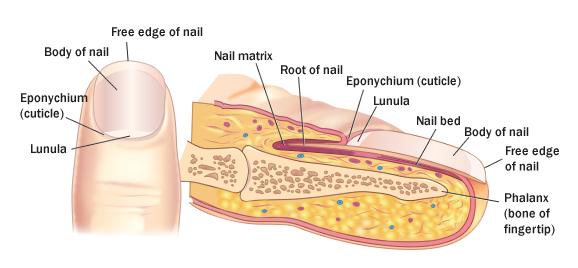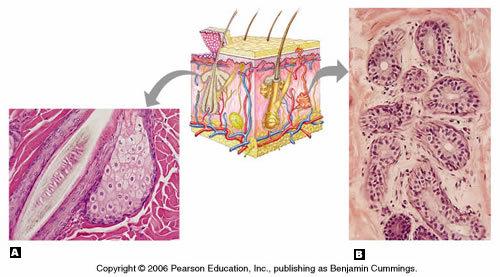SKIN STRUCTURE

The main structural features in epidermis of the skin
The dense irregular connective tissue making up the dermis is made of two principle layers
1. Papillary Layer
2. Reticular Layer
More superficial dermal region composed of Areolar CT.
Dermal Papillae, finger prints above dermal ridges
Meissner's corpuscle- touch
Papillary Layer
The deepest skin layer. Composed of dense irregular connective tissue and contains many arteries and veins, sweat and sebaceous glands, and pressure receptors (Pacinian Corpuscles)
Reticular Layer
Bed sores (decubitus ulcers)
Occur in bedridden patients that are not turned regularly enough. The weight of the body exerts pressure on the skin, especially over bony projections, which leads to restrictions of the blood supply and tissue death.
Decubitus Ulcers
in patients with, diabetes (Type II) or burns
When in newborns a chemical called bilirubin rises high
Jaundice
STRUCTURE OF THE NAIL

A single row of cells immediately adjacent to the dermis. Alternate name is Stratum germinativum, 10% to 25% are melanocytes, which thread their processes through this and the adjacent layers of keratinocytes. Also has Tactile cells in this layer.
Stratum Basale (Basal Layer)
Several cell layers immediately superficial to the basal layer. cells in this layer appear spiky.
Stratum Spinosum (Spiky Layer)
Contains granules of two types:
1)lamellated granules and 2)keratohyaline granules.
The lamellated granules contain a water proofing glycolipid that is secreted in the extracellular space; and the keratohyaline granules combine with intermediate filaments in the more superficial layers to form the keratine fibrils. Upper boarder cells are beginning to die.
Stratum Granulosum (Granular layer)
Thin translucent band of flattened dead keratinocytes. This layer is found in the palm of hands and soles of the feet.
Stratum Lucidum (Clear Layer)
Consists of 20-30 layers and accounts for the bulk of the epidermal thickness. This is the layer where you would find keratinized cells.
Stratum Corneum (Horny Layer)
The external body covering, protects, insulates, cushions, regulates body temperature, metabolic duties
SKIN, OR INTEGUMENT
Cells of the Epidermis
Keratinocytes, Melanocytes, Epeidermal dendritic cells (Langerhan's Cells), Tactile Cells
Skin Color
melanin, brown pigment
carotene,yellowish-orange pigment
Jaundice
tissue becomes yellowed, is almost always diagnostic for liver disease.
Addison's Disease
bronzing of the skin hints that a person's adreanl cortex is hypoactive.
Parts of the Nail
Body: The visible attached portions.
Free Edge: The portion of the nail that grows out away from the body.
Root: The part that is embedded in the skin and adheres to the epithelial nail bed.
Nail Folds: Skin folds that overlap the borders of the nail.
Eponychium: The thick proximal nail fold commonly called the cuticle.
Parts of the Nail
Nail Bed: Extension of the stratum basale beneath the nail.
Nail matrix: The thickened nail bed containing germinal cells responsible for nail growth. As the matrix produces the nail cells, they become heavily
keratinized and die. Thus, nails like hairs, are mostly non-living materials.
Lunule: The proximal region of the thickened nail matrix. Everywhere nails are transparent and nearly colorless, but appear pink because if bllod supply.
Small bands of smooth muscle cells connect each hair follicle to the papillary layer of the dermis.
During cold or fright, "goosebumps"
Arrector Pili Muscle
A small nipple of dermal tissue that protrudes into the hair bulb from the connective tissue sheath and provides nutrition to the growing hair.
Papilla
Eccrine Glands (merocrine sweat glands)
distributed all over the body.
Temperature regulation
Appocrine Glands
found predominately in the axillary and genital areas, these glands secrete a milky protein- and a fat- rich substance excellent nutrient medium for bacterium. and sex glands, secretes pheromones for some animals.
Cutaneous Glands

Blackheads
are accumulations of dried sebum, bacteria, and melanin from epithelial cells in the oil duct.
Acne
is an active infection of the sebaceous glands.